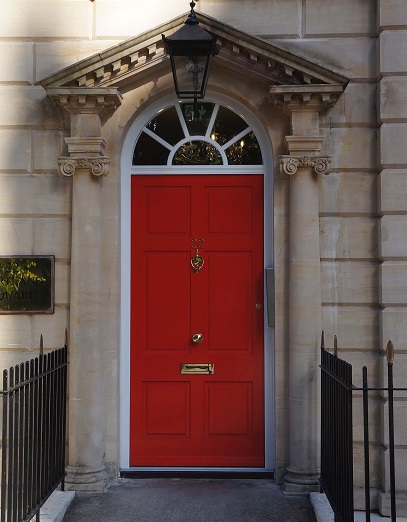External doors
Doors are openable barriers at the entrance to buildings, rooms or other spaces such as cupboards that allow people, vehicles or goods to enter and leave. They most commonly swing on hinges and include furniture or ironmongery that allows them to open, close, stay closed and sometimes to lock.
External doors typically have a more demanding role than internal doors as they are exposed to outside conditions and must protect the interior from the elements as well as from intrusion. The aesthetic style of an external door can also be a more important consideration than for internal doors as it creates the entrance and/or exit of a building and so can leave an impression on users and passers-by.
There are many different types of external door design, often depending on the specific purpose and use requirement. For example, garages will typically use a rolling shutter door made of steel and fitted with a remote-control system which automatically raises and closes it; public and commercial buildings often use revolving doors comprising several leaves that radiate from a central shaft to form compartments, rotating about a vertical axis. For more information, see Types of door.
In terms of materials, timber is widely-used for external doors, but more recently, composite PVC doors have been adopted as an alternative to timber in some dwellings. Other common materials include glass, steel aluminium and so on.
Timber doors can be inexpensive and provide a natural aesthetic, but they are also prone to twisting, warping, and rot, and require treating and regular maintenance to protect them from the weather.
Sliding patio doors and modern home doors can be made from aluminium, which benefits from being lightweight and strong and requires relatively little maintenance. Steel doors can also have the advantages of durability, and easy maintenance. They also can present the appearance of heightened security, although this is not necessarily so as a door is no stronger than its frame.
As external doors have an important role to play in securing a building, they will often be fitted with locks. A common lock used on external doors is the mortice deadlock which is positioned on the inside face of the door and can be key-operated from both inside and out. Nightlatches, also known as secondary locks, can either be standard (locks automatically unless the latch is held back), or deadlocked (locks automatically and requires a key inside and outside). For more information, see Types of lock.
Other security features in front doors might include a door chain, a viewing hole, a London bar, an entry alarm, audio and video communication systems and so on. Non-security related features that are often included on external doors include a letter box, number/s (fixed with screws or other fasteners), door-knocker, door bell, etc.
Approved Document Q - Security – Dwellings, requires that reasonable provision is made to prevent unauthorised access, and that easily accessible doors are sufficiently robust and fitted with appropriate hardware. For more information see: Approved document Q.
Door Energy Rating schemes are based on a traffic-light style A-G ratings system for energy efficiency similar to the labelling system used for fridges, washing machines, cookers and so on. An A rating indicates a good level of energy efficiency, whilst G is the lowest rating. Low rated doors will not normally satisfy building regulations requirements. For more information see: Door Energy Rating.
[edit] Related articles on Designing Buildings Wiki
Featured articles and news
RTPI leader to become new CIOB Chief Executive Officer
Dr Victoria Hills MRTPI, FICE to take over after Caroline Gumble’s departure.
Social and affordable housing, a long term plan for delivery
The “Delivering a Decade of Renewal for Social and Affordable Housing” strategy sets out future path.
A change to adoptive architecture
Effects of global weather warming on architectural detailing, material choice and human interaction.
The proposed publicly owned and backed subsidiary of Homes England, to facilitate new homes.
How big is the problem and what can we do to mitigate the effects?
Overheating guidance and tools for building designers
A number of cool guides to help with the heat.
The UK's Modern Industrial Strategy: A 10 year plan
Previous consultation criticism, current key elements and general support with some persisting reservations.
Building Safety Regulator reforms
New roles, new staff and a new fast track service pave the way for a single construction regulator.
Architectural Technologist CPDs and Communications
CIAT CPD… and how you can do it!
Cooling centres and cool spaces
Managing extreme heat in cities by directing the public to places for heat stress relief and water sources.
Winter gardens: A brief history and warm variations
Extending the season with glass in different forms and terms.
Restoring Great Yarmouth's Winter Gardens
Transforming one of the least sustainable constructions imaginable.
Construction Skills Mission Board launch sector drive
Newly formed government and industry collaboration set strategy for recruiting an additional 100,000 construction workers a year.
New Architects Code comes into effect in September 2025
ARB Architects Code of Conduct and Practice available with ongoing consultation regarding guidance.
Welsh Skills Body (Medr) launches ambitious plan
The new skills body brings together funding and regulation of tertiary education and research for the devolved nation.
Paul Gandy FCIOB announced as next CIOB President
Former Tilbury Douglas CEO takes helm.
UK Infrastructure: A 10 Year Strategy. In brief with reactions
With the National Infrastructure and Service Transformation Authority (NISTA).























